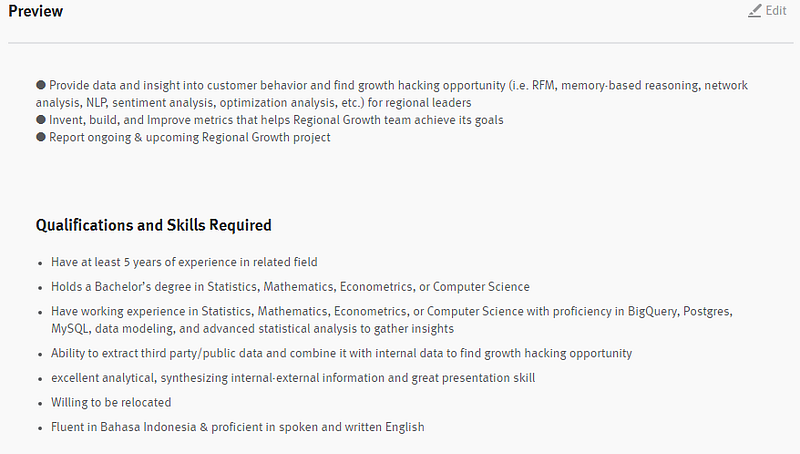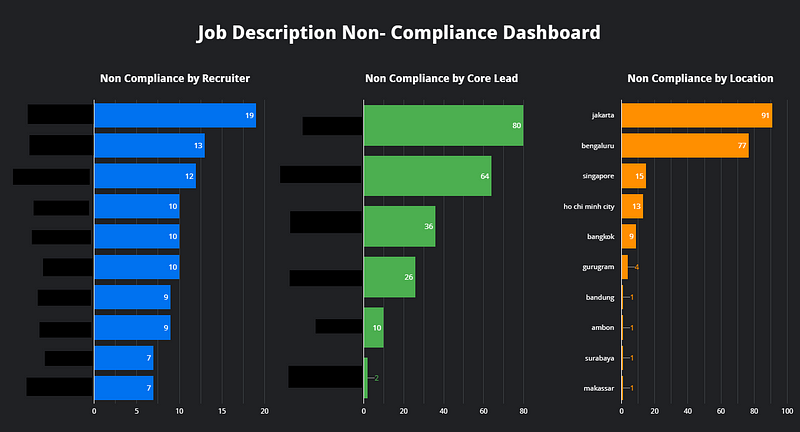By Shawn Wong & Vincentia Janice
If you’re a fan of the Marvel Cinematic Universe (MCU) or have seen the movie Doctor Strange, you’ll be familiar with the ‘Book of the Vishanti’. For the uninitiated: This book in the MCU is a collection of spells, history, and personal accounts recorded by practitioners over centuries, including notes from Doctor Strange himself.

Gojek needed a similar book of the Vishanti — one that captured the legacies of our many Job Descriptions. But importantly, enhance and enable our recruiters to write good, meaningful JDs that spur a potential candidate to work with Gojek.
It’s no secret Gojek actually had sub-par job descriptions open to the public. These were standards we fell well short of. Job Descriptions (JDs) reflect the values, characteristics, and culture of a company. Essentially, a deep clean up was long overdue.

Well-written job descriptions are one of the quickest and most effective recruiting tools to draw in quality talent. Just think about it — if there’s a highly qualified senior software engineer sifting through mundane job openings, publishing a well-crafted, witty, enticing JD would help ours stand out from the rest. It’s that simple.
But, what wasn’t simple was implementing this change across our entire global recruiting family. We’re spread across Thailand, Singapore, Vietnam, Indonesia, and India. Things get complicated when we have many sources of truth. In this blog, we share what this process has been like, and how you can follow suit with your own company to have better JDs.
Making the change
Revamping a vast number of active job descriptions is similar to changing the wheels of a moving car — more so, when you factor in how quickly Gojek is scaling. We knew we needed to dedicate an entire project team to make this happen.
Assembling your team
To begin, you’ll need a project leader who knows in and out of the recruiting process. This is a project management job answerable to all recruiters. You’ll also need a content writer who can catch grammatical errors and smooth out sentence structures. Finally, add on several folks who have a sharp attention to detail, and are relentless in seeing things through till the end (this last part is particularly crucial. Read on to find out why).
Step 1: Create the mold
Recruiters aren’t writers. It’s not their core job. Thus, create a mold for everyone to follow. To do so, think about what your company stands for, its brand voice, and what you want to convey through every JD. Be as honest and thorough as you can at this stage — you’re setting the bar right now.
Then, identify the main ingredients every JD should include. Our team decided on these four:
- The tone of voice: Does it sound like Gojek just from the writing alone?
- Inclusivity: The JD should be welcoming, diverse, and inclusive, taking into consideration different cultures, ages, genders, and backgrounds
- About the Role: What makes this role unique from similar ones in other companies?
- About the Team: A space to humanise the team. Who wants to read all about work stuff, anyway?
“Forget Everything You Think You Know.” — Mordome
Step 2: Audit everything, leave nothing behind
This is the meaty part. With the mold in place, compile all the JDs your company has published onto a Google Sheet. Our team divided up the JDs and audited a whopping 2,262 in total. It wasn’t fun, but it needed to get done. Welcome to the GRIND.
This is when the core team comes under pressure. When you have dozens of recruiters asking why we’re changing something, or have increased work for hiring managers by asking them to give us more meaningful information to construct better JDs. It’s not easy waging war on many fronts, but it wasn’t meant to be easy. We were in search of excellence, for a standard that we should be proud of. All our JDs had to have the Gojek flavour of enticing candidates to apply.
“I could have done better.” — Doctor Strange

Step 3: Create an ecosystem that works
Now, it was time to change the way 60+ recruiters wrote job descriptions across different geographies. Having well-crafted tools and templates won’t mean much if no one uses it.
Our team frequently collaborated with the Recruiting Operations team to implement these changes from the ground up. Consider the recruiting process your company follows — where does it start? Which is the best stage to conduct quality checks? Work with your Applicant Tracking System and put in place an approval system to ensure every one of your JDs moving forward is compliant.
Additionally, we created a Sustainable Guideline & Resource Centre — a dedicated Google site that acts as a “one-stop information centre” for all things JD. We detailed every stage of the JD writing and posting process on this site, from formatting and content requirements, tone of voice examples, to posting instructions. Be sure to include these resources in early conversations with recruiters and hiring managers, over-communicating their availability and accessibility in every training session and email update from your team.

Needless to say, before you begin this exercise, interview recruiters, find out pain points and why things are not up to the mark. For example: Recruiters have bad JDs because hiring managers simply don’t give enough information. In which case, it’s critical to ask the right questions to hiring managers for better JDs.
“You cannot beat a river into submission. You have to surrender to its current, and use its power as your own.” — The Ancient One
What to Expect
Any process of change will be uncomfortable for those involved, especially one as big as this. Common reactions such as “Why do I have to do this?” “Why does it matter?”, “The old ways work just fine!”, or “This is taking too much of my time which I would rather spend recruiting” will be frequent push-backs.
Do your best to stand your ground. Factor in time to properly explain the “so what” of the project whenever you can, gaining empathy and understanding of its importance and benefit in the long-run. This lack of “buy-in” from recruiters and hiring managers is still something we encounter today, but has significantly eased up with time.
Lastly, we want to reiterate the most critical element to successfully pulling this monster of a project off: assembling the right team to do the job. Every member must be willing to roll up their sleeves and do the dirty work. They must be relentless in seeing this project through, regardless of how difficult the everyday tasks may be.

Are we perfect now? Not yet. We want to do better. We want to create a gold standard. But for now, our JDs are probably one of the best, and definitely miles ahead of what we used to have.
What’s important: Gojek’s stellar JD Book of the Vishanti is now a living, breathing force used by many recruiters and hiring managers to write better JDs.

Click here to read more stories from the vault. Click below to go through amazing JDs and apply for something you like!


